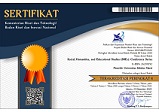Integration of Culturally Responsive Teaching and Augmented Reality to Improve Mathematics Learning Outcomes Based on Elementary School Students' Adversity Quotient
Abstract
The low mathematics learning outcomes among elementary school students in Ngrampal District, Sragen, highlight the need for developing innovative learning approaches that are adaptive to student characteristics. This study aims to investigate the effect of an Augmented Reality (AR)-based Culturally Responsive Teaching (CRT) approach on mathematics learning outcomes, considering students' Adversity Quotient (AQ) levels. This research employed a quasi-experimental method with a 3x3 factorial design, involving sixth-grade students from nine elementary schools. Participants were classified into three learning model groups (CRT-AR, CRT, and direct instruction) and three AQ categories (quitters, campers, and climbers), with data collected using a validated AQ questionnaire and a mathematics achievement test. The findings indicated a significant effect of the learning approach on mathematics learning outcomes, with the CRT-AR approach yielding the highest achievement compared to the other methods. Furthermore, a significant interaction effect was found between the learning approach and AQ level. Students in the 'climbers' category demonstrated the most superior achievement, particularly within the CRT-AR treatment group. In conclusion, the integration of the CRT approach with AR technology is an effective intervention for improving the mathematics learning outcomes of elementary school students, especially for those with a high Adversity Quotient (AQ)
Keywords
Culturally Responsive Teaching, Augmented Reality, Mathematics Learning Outcomes, Adversity Quotient, Elementary School
Full Text:
PDFRefbacks
- There are currently no refbacks.




